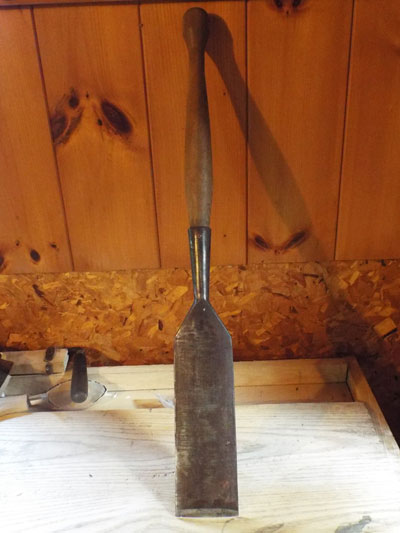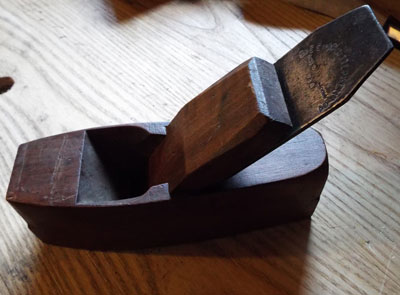Recognizing a Quality Hand Tool
by Kerry Lambertson
Finland, MN
Click on any picture to see a larger version.
Any serious craftsman or woman will know the value of a high quality tool, but it can be difficult
to separate the wheat from the chaff given the seemingly limitless spread of hand tools available
on the market today. Recent years have seen a wonderful renaissance in the manufacture, import,
and widespread availability of hand tools based on traditional designs. Additionally, it is my
opinion that some of the best woodworking tools available are a century or more old.
Within living memory for some, handwork was linked directly to food on the table and a roof
overhead. Knowing this, the prudent craftsman demanded tools that were of enduring quality,
made accurately and from high quality materials. Though not always as essential to survival as in
previous times, a worthwhile tool will still make the difference between an efficient, accurate, and
enjoyable woodworking experience and a frustrating waste of time. Many excellent designs and
methods evolved during earlier periods of American toolmaking and much worthwhile
knowledge can be gleaned from the study of these old tools. I hope I can share some of what I have
learned about the selection, tuning, and care of fine quality woodworking hand tools.

|
I am not a tool historian, but I have learned to recognize a quality antique tool when I see one. I've
also learned how to choose fine quality tools on the occasions when I require a brand new tool.
In sharing what I've learned, I'll first say that though I love a bargain as well as anyone, investing
in quality is never amiss. Through many exasperating trials with poor quality tools I now often say
that I would rather have one plane, chisel, or drawknife that can be relied upon than an entire shop
full of tools of inferior quality. My advice is that if you have the budget to purchase one "top of the
line" tool or ten tools that "are probably good enough," buy the one. You will never regret it and
before long you will have saved enough for the next tool that will be a faithful friend for years to
come.
That said, as earlier mentioned, many of the finest tools are old and thought to be obsolete, and are
lying in heaps in the derelict barns and flea markets of America. There are tools of marvelous
quality to be had at low prices if one is willing to develop a bit of an eye, and invest some time into
restoration and tuneup. Many old tools have been misused, abused, or neglected. Sadly, learning
to tell the quick from the dead is part of the process. Surface rust can be scrubbed away, but pitting
of any depth is probably a dealbreaker. A chipped edge can be reground, broken plane totes can
be glued, and chisel handles turned and replaced. However, a cracked or badly mushroomed socket on
a chisel, a broken eye on an axe or hatchet, or deep chipping around the mouth of a plane are all
reasons to keep moving. Occasionally, the tool collector will come upon a tool that has been very
cleverly repaired, whether brazed, welded, or soldered, or with parts that have obviously been
replaced. If these repairs seem sturdy and serviceable, they probably are, and it is my opinion that
a well executed repair adds to the character of a tool.

|
With a bench grinder, perhaps a combination disc/belt sander, a bit of steel wool, abrasive paper,
machine oil, and time, a great many fine quality tools that were headed for the scrapyard can be
made serviceable again for years to come. It all comes down to a very personal equation
concerning how much time and love a tool is worth to its owner. I feel a sense of satisfaction in
saving these antique beauties from decay and destruction, and like to think that their preservation
contributes to the legacy of craftsmanship.
There are also a great number of brand new tools that are well worth the price that they command.
Particularly in this era of handtool renaissance, small producers are creating tools worth passing
from one generation to the next, and they deserve our recognition and support. If you feel unsure
about which companies are making a product worthy of your investment, ask fellow craftsmen. If
you're new to woodworking and don't know anyone else who is involved, consider attending a
gathering such as
Woodworking in America
or
Handworks
. If all else fails, call the company
directly and ask questions. My experience is that most toolmakers and woodworkers are more than
willing to discuss tools till the cows come home, and that anyone worth their salt will be more
interested in describing processes, techniques, and methods than pushing a sale. A conversation
with a representative will tell you a great deal about a firm's quality or the lack thereof.
A high quality hand tool should feel good in the hands, and look good too. Though any skilled
craftsman can sharpen a tool, when a new tool arrives dull I must infer that the company that made
it does not consider sharpness to be important. Ill-fitting or misaligned handles and crudely made
castings with sharp edges or loose fits are additional signs of a toolmaking firm's lack of interest
in quality.
Most of the woodworking tools described here will have cutting edges made of high carbon tool
steel. When tempered properly, this steel will hold a razor edge that is tough enough to go through
oak knots without chipping. Steel of this quality, when touched to the wheel of a bench grinder or
abrasive belt on a sanding machine, will shoot a shower of bright, hot, fast moving sparks. This
goes for antique as well as new tools, and a steel that fails to measure up to this test either was of
low quality in the first place or has had its temper destroyed somewhere along the line.
To a surprising degree the adage that quality speaks for itself rings true here. Fancy bells and
whistles and newfangled gimmicks pale when compared with the elegant simplicity of a skillfully
designed, made, and maintained tool working at its intended purpose. This article is not a plug for
any specific tool company, but it is a call for woodworkers to demand nothing less than the highest
quality in tools and I hope it has offered a few useful thoughts in how to go about locating these
tools. Fine work demands fine tools, and fine tools create a peaceful and pleasurable work
experience, which, after all, is why we got in to this, isn't it?
Kerry trained as a
boatbuilder. He now builds furniture and teaches
woodworking skills at various gatherings and folk schools. He
has a particular passion for hand work and efficient use of
hand tools, and enjoys designing and building items of
day-to-day necessity.
You can email Kerry at
k_lambertson@yahoo.com
.
Return to
Wood News
front page


